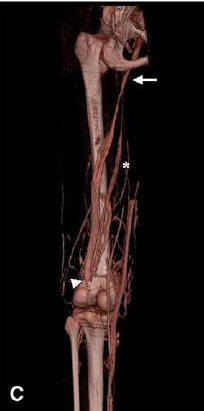|
Gorka Bastarrika G y col. New techniques for the evaluation
and therapeutic planning of patients with KlippeleTreŽnaunay syndrome J Am Acad Dermatol 2007;56:242-9.) |
|
|
| Fig 1. A, Geographic stain on thigh and
knee of a 26-year-old female with KlippeleTreŽnaunay syndrome (patient 5). B, MDCT images. C, Volume rendered images of the right lower extremity. Severely dilated lateral veins (arrows) extending into the pelvis. Antero-posterior view. D, Duplication of the superficial femoral vein (arrows). Note a normal superficial femoral vein in the contralateral limb (arrowhead ). Posterio-anterior view. |
|
|
| Fig 2. A, Geographic stain on lateral thigh,
knee, and leg of a 34-year-old male with KlippeleTreŽnaunay syndrome (patient 7). B, MR venography. Persistent lower sciatic veins (arrow) originate in the region of the popliteal vein and terminate in the proximal superficial femoral vein (arrowhead ). |
   |
| Fig 3. A, Geographic stain on the foot of a
24-year-old male with KlippeleTreŽnaunay syndrome (patient 8). B, MDCT images. C, MDCT venography. Normal superficial femoral vein (arrow) with aplasia of the popliteal vein (arrowhead ), and a persistent sciatic vein (asterisk). |




